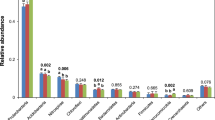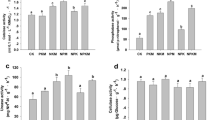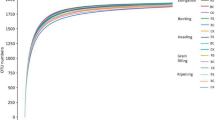Abstract
This study focuses on the effects of long-term rice rotated with milk vetch being as green manure on the composition of bacteria in rice roots. The endophytic bacterial communities in rice roots of the rice–rice–milk vetch (R-R-MV) and the rice–rice–winter fallow (R-R-WF) crop rotations with a 28-year research history were investigated using combined culture-dependent and culture-independent methods. It was found that the endophytic bacterial population in rice roots with the green manure was significantly higher than that of without it. There were 169 and 77 strains of endophytic bacteria that were isolated from rice roots of the R-R-MV and the R-R-WF, respectively. The 16S rRNA gene analysis shows that the 77 R-R-WF bacteria belong to 15 species of 14 genera while the other 169 R-R-MV bacteria belong to 21 species of 19 genera, in which Herbaspirillum and Cedecea were two mutually dominant populations and Burkholderia, Pseudomonas, Sphingomonas, and Pantoea accounted for large proportions of the endophytic bacteria in rice roots through R-R-MV rotation. The analysis of 16S rDNA clone libraries showed that the Shannon–Weaver diversity index of endophytic bacteria in R-R-MV approximates that in R-R-WF rotation, whereas the richness indexes of Chao 1 and ACE in R-R-MV rotation system were significantly higher than those in R-R-WF rotation. The diversity of endophytic bacteria was richer in R-R-MV. Both the culture-dependent and the culture-independent method revealed significant effect of long-term different tillage systems on the microbial community.




Similar content being viewed by others
References
Bending GD, Turner MK, Rayns F, Marx MC, Wood M (2004) Microbial and biochemical soil quality indicators and their potential for differentiating areas under contrasting agricultural management regimes. Soil Biol Biochem 36:1785–1792
Chelius MK, Triplett EW (2001) The diversity of archaea and bacteria in association with the roots of Zea mays L. Microb Ecol 41:252–263
Compant S, Clément C, Sessitsch A (2010) Plant growth-promoting bacteria in the rhizo- and endosphere of plants: their role, colonization, mechanisms involved and prospects for utilization. Soil Biol Biochem 42:669–678
Drinkwater LE, Wagoner P, Sarrantonio M (1998) Legume-based cropping systems have reduced carbon and nitrogen losses. Nature 396:262–265
Elbeltagy A, Nishioka K, Sato T, Suzuki H, Ye B, Hamada T, Isawa T, Mitsui H, Minamisawa K (2001) Endophytic colonizationand in planta nitrogen fixation by a Herbaspirillum sp. isolated from wild rice species. Appl Environ Microbiol 67(11):5285–5293
Gao JS, Cao WD, Li DC, Xu MG, Zeng XB, Nie J, Zhang WJ (2011) Effects of long-term double-rice and green manure rotation on rice yield and soil organic matter in paddy field. Acta Ecologica Sinica 31(16):4542–4548
Gao JS, Xu MG, Qin DZ (2008) Effects of long-term rotation of rice, rice and milk vetch on growth and yield in rice. Hunan Agric Sci 6:25–27
Garbeva P, van Overbeek LS, van Vuurde JWL, van Elsas JD (2001) Analysis of endophytic bacterial communities of potato by plating and denaturing gradient gel electrophoresis (DGGE) of 16S rDNA based PCR fragments. Microb Ecol 41:369–383
Good IL (1953) The population frequencies of species and the estimation of population parameters. Biometrika 40:237–264
Graff A, Stubner S (2003) Isolation and molecular characterization of thiosulfate-oxidizing bacteria from an Italian rice field soil. Syst Appl Microbiol 26(3):445–452
Hardoim PR, van Overbeek LS, van Elsas JD (2008) Properties of bacterial endophytes and their proposed role in plant growth. Trends Microbiol 16(10):463–471
Hill TCJ, Walsh KA, Harris JA, Moffett BF (2003) Using ecological diversity measures with bacterial communities. FEMS Microbiol Ecol 43:1–11
Kaiser O, Pühler A, Selbitschka W (2001) Phylogenetic analysis of microbial diversity in the rhizoplane of oilseed rape (Brassica napus cv. Westar) employing cultivation-dependent and cultivation-independent approaches. Microb Ecol 42:136–149
Kang SH, Cho HS, Cheong H, Ryu CM, Kim JF, Park SH (2007) Two bacterial entophytes eliciting both plant growth promotion and plant defense on pepper (Capsicum annuum L.). J Microbiol Biotechnol 17(1):96–103
Kim OS, Cho YJ, Lee K, Yoon SH, Kim M, Na H, Park SC, Jeon YS, Lee JH, Yi H, Won S, Chun J (2012) Introducing EzTaxon-e: a prokaryotic 16S rRNA gene sequence database with phylotypes that represent uncultured species. Int J Syst Evol Microbiol 62:716–721
Lane DJ (1991) 16S/23S rRNA sequencing. In: Stackebrandt E, Goodfellow M (eds) Nucleic acid techniques in bacterial systematics. Wiley, New York, pp 115–175
Langenheder S, Bulling MT, Solan M, Prosser JI (2010) Bacterial biodiversity–ecosystem functioning relations are modified by environmental complexity. PLoS ONE 5(5):e10834. doi:10.1371/journal.pone.0010834
Larkin RP (2003) Characterization of soil microbial communities under different potato cropping systems by microbial population dynamics, substrate utilization, and fatty acid profiles. Soil Biol Biochem 35:1451–1466
MacRae RJ, Mehuys GR (1985) The effect of green manuring on the physical properties of temperate-area soils. Adv Soil Sci 3:71–94
Mano H, Morisaki H (2008) Endophytic bacteria in the rice plant. Microb Environ 23:109–117
Montañez A, Blanco AR, Barlocco C, Beracochea M, Sicardi M (2012) Characterization of cultivable putative endophytic plant growth promoting bacteria associated with maize cultivars (Zea mays L.) and their inoculation effects in vitro. Appl Soil Ecol 58:21–28
Morrissey JP, Dow JM, Mark GL, O'Gara F (2004) Are microbes at the root of a solution to world food production? EMBO Rep 5(10):922–926
Pariona-Llanos R, Ferrara FIS, Soto HH, Barbosa HR (2010) Influence of organic fertilization on the number of culturable diazotrophic endophytic bacteria isolated from sugarcane. Eur J Soil 46(6):387–393
Peters RD, Sturz AV, Carter MR, Sanderson JB (2003) Developing disease-suppressive soils through crop rotation and tillage management practices. Soil Till Res 72:181–192
Robertson GP, Paul EA, Harwood RR (2000) Greenhouse gases in intensive agriculture: contributions of individual gases to the radioactive forcing of the atmosphere. Science 289:1922–1925
Roncato-Maccari LDB, Ramos HJO, Pedrosa FO, Alquini Y, Chubatsu LS, Yates MG, Rigo LU, Steffens MBR, Souza EM (2003) Endophytic Herbaspirillum seropedicae expresses nif genes in gramineous plants. FEMS Microbiol Ecol 45(1):39–47
Schloss PD, Westcott SL, Ryabin T, Hall JR, Hartmann M, Hollister EB, Lesniewski RA, Oakley BB, Parks DH, Robinson CJ, Sahl JW, Stres B, Thallinger GG, Van Horn DJ, Weber CF (2009) Introducing mothur: open-source, platform-independent, community supported software for describing and comparing microbial communities. Syst Appl Microbiol 75:7537–7541
Silva HSA, Tozzi JPL, Terrasan CRF, Bettiol W (2012) Endophytic microorganisms from coffee tissues as plant growth promoters and biocontrol agents of coffee leaf rust. Biol Control 63(1):62–67
Stark C, Condron LM, Stewart A, Di HJ, O’Callaghan M (2007) Influence of organic and mineral amendments on microbial soil properties and processes. Appl Soil Ecol 35:79–93
Sun L, Qiu FB, Zhang XX, Dai X, Dong XZ, Song W (2008) Endophytic bacterial diversity in rice (Oryza sativa L.) roots estimated by 16S rDNA sequence analysis. Microb Ecol 55:415–424
Tamura K, Peterson D, Peterson N, Stecher G, Nei M, Kumar S (2011) MEGA5: molecular evolutionary genetics analysis using maximum likelihood, evolutionary distance, and maximum parsimony methods. Mol Biol Evol 28:2731–2739
Tejada M, Gonzalez JL, García-Martínez AM, Parrado J (2008) Effects of different green manures on soil biological properties and maize yield. Bioresource Technol 99:1758–1767
Thompson JD, Gibson TJ, Plewniak F, Jeanmougin F, Higgins DG (1997) The CLUSTAL_X windows interface: flexible strategies for multiple sequence alignment aided by quality analysis tools. Nucleic Acids Res 25:4876–4882
Turco RF, Bischoff M, Breakwell DP, Griffith DR (1990) Contribution of soil-borne bacteria to the rotation effect in corn. Plant Soil 122:115–120
Yang ZP, Gao JS, Zheng SX, Nie J, Xu MG, Xie J, Liao YL (2011) Effects of long-term winter planting-green manure on microbial properties and enzyme activities in reddish paddy soil. Soils 43(4):576–583
Yao HY, Jiao XD, Wu FZ (2006) Effects of continuous cucumber cropping and alternative rotations under protected cultivation on soil microbial community diversity. Plant Soil 284:195–203
Acknowledgments
This work was supported by the National Natural Science Foundation of China (grant nos. 41271273, 41025004), the National High Technology Research and Development Program of China (2012AA101403), and Special Scientific Research Funds for Commonwealth Agricultural Industry (201103005-01).
Author information
Authors and Affiliations
Corresponding author
Electronic supplementary material
Below is the link to the electronic supplementary material.
ESM 1
(PDF 273 kb)
Rights and permissions
About this article
Cite this article
Zhang, XX., Gao, JS., Cao, YH. et al. Long-Term Rice and Green Manure Rotation Alters the Endophytic Bacterial Communities of the Rice Root. Microb Ecol 66, 917–926 (2013). https://doi.org/10.1007/s00248-013-0293-1
Received:
Accepted:
Published:
Issue Date:
DOI: https://doi.org/10.1007/s00248-013-0293-1




